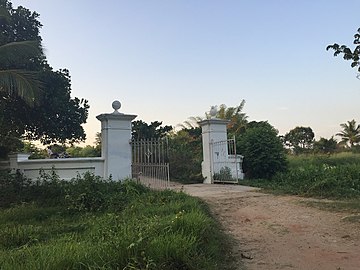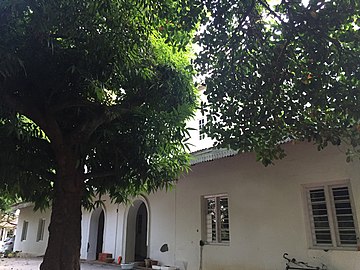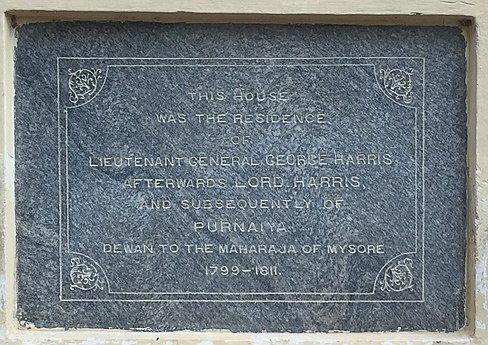
Tipu Sultan, commonly referred to as Sher-e-Mysore or "Tiger of Mysore", was the Indian Muslim ruler of the Kingdom of Mysore based in South India. He was a pioneer of rocket artillery. He introduced a number of administrative innovations during his rule, including a new coinage system and calendar, and a new land revenue system, which initiated the growth of the Mysore silk industry. Tipu was also a pioneer in introducing Channapatna toys. He expanded the iron-cased Mysorean rockets and commissioned the military manual Fathul Mujahidin, He deployed the rockets against advances of British forces and their allies during the Anglo-Mysore Wars, including the Battle of Pollilur and Siege of Srirangapatna.
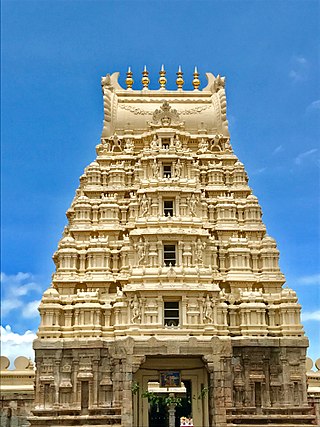
Srirangapatna is a town and headquarters of one of the seven Taluks of Mandya district, in the Indian State of Karnataka. It gets its name from the Ranganthaswamy temple consecrated around 984 CE. Later, under the British rule, the city was renamed to Seringapatnam. Located near the city of Mandya, it is of religious, cultural and historic importance.
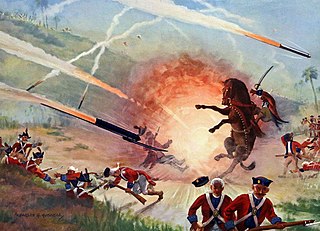
The Battle of Pollilur, also known as the Battle of Polilore or Battle of Perambakam, took place on 10 September 1780 at Pollilur near Conjeevaram, the city of Kanchipuram in present-day Tamil Nadu state, India, as part of the Second Anglo-Mysore War. It was fought between an army commanded by Tipu Sultan of the Kingdom of Mysore, and a British East India Company force led by William Baillie. The EIC force suffered a high number of casualties before surrendering. It was the worst loss the East India Company suffered on the subcontinent until Chillianwala. Benoît de Boigne, a French officer in the service of 6th Regiment of Madras Native Infantry, wrote, "There is not in India an example of a similar defeat".

The Anglo-Mysore Wars were a series of four wars fought during the last three decades of the 18th century between the Sultanate of Mysore on the one hand, and the British East India Company, Maratha Empire, Kingdom of Travancore, and the Kingdom of Hyderabad on the other. Hyder Ali and his succeeding son Tipu fought the wars on four fronts: with the British attacking from the west, south and east and the Nizam's forces attacking from the north. The fourth war resulted in the overthrow of the house of Hyder Ali and Tipu, and the dismantlement of Mysore to the benefit of the East India Company, which took control of much of the Indian subcontinent.
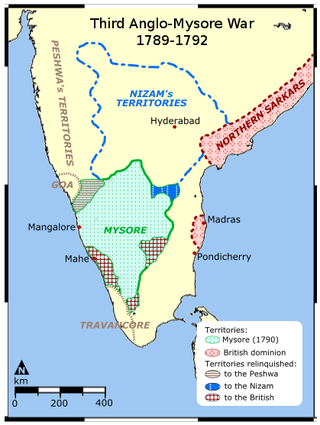
The Third Anglo-Mysore War (1790–1792) was a conflict in South India between the Kingdom of Mysore and the British East India Company, the Kingdom of Travancore, the Maratha Empire, and the Nizam of Hyderabad. It was the third of four Anglo-Mysore Wars.

The Fourth Anglo-Mysore War was a conflict in South India between the Kingdom of Mysore against the British East India Company and the Hyderabad Deccan in 1798–99.

George Harris, 1st Baron Harris GCB was a British soldier.

The siege of Seringapatam was the final confrontation of the Fourth Anglo-Mysore War between the British East India Company and the Kingdom of Mysore. The British, with the allied Nizam Ali Khan, 2nd Nizam of Hyderabad and Marathas, achieved a decisive victory after breaching the walls of the fortress at Seringapatam and storming the citadel. The leader of the British troops was Major General David Baird, among the lesser known allies were the Portuguese in Goa and Damaon. Tipu Sultan, the de facto ruler after the death of his father, who had usurped the throne of Mysore, was killed in the action. The British restored the Wodeyar dynasty back to power after the victory through a treaty of subsidiary alliance, Krishnaraja Wodeyar III was crowned the King of Mysore. However, they retained indirect control of the kingdom's external affairs.

General James Stuart (1741–1815) was a British Army officer who served in North America during the American Revolutionary War and took part in various campaigns in British India. He was the first General Officer Commanding, Ceylon and second Military Governor of British Ceylon. He was appointed on 1 March 1796 and was Governor until 1 January 1797. He was succeeded by Welbore Ellis Doyle.

KrishnacharyaPurnaiah, popularly known as DewanPurnaiah, was an Indian administrator, statesman, and strategist who served as the first dewan of Mysore from 1782 to 1811 under the Dewani System established by Tipu Sultan. He was instrumental in the restoration of the rule of the Kingdom of Mysore to the Wadiyar dynasty. After the death of Tipu Sultan, he continued to advice the succeeding child monarch Krishnaraja III.
The captivity of Mangalorean Catholics at Seringapatam (1784–1799) was a 15-year imprisonment of Mangalorean Catholics and other Christians at Seringapatam, in the Carnataca region of India by Tippu Sultan, the de facto ruler of the Kingdom of Mysore. Estimates of the number of captives range from 30,000 to 80,000, but the generally accepted figure is 60,000, as stated by Tipu in the Sultan-ul-Tawarikh. The captivity was the most disconsolate period in the community's history.
The captivity of Kodavas (Coorgis) at Seringapatam was the period of capture, deportation, and imprisonment of Kodava Takk speaking Coorgis who rebelled against Tippu Sultan, the de facto ruler of the Kingdom of Mysore, they were caught during a number of attempts to suppress their rebellion in the 1780s.

The siege of Bangalore was a siege of the town and fortifications of Bangalore during the Third Anglo-Mysore War by forces of the British East India Company, led by Charles, Earl Cornwallis against a Mysorean garrison, while Tipu Sultan, Mysore's ruler, harried the camps and positions of the besiegers. Arriving before the town on 5 February 1791, Cornwallis captured the town by assault on 7 February, and after six weeks of siege, stormed the fortress on 21 March.

The Seringapatam Medal, or Sri Ranga Pattanam Medal, is a campaign medal that was awarded by the Governor-General of India to all British and Indian soldiers who participated in the British victory in the Battle of Seringapatam in 1799.

Garrison Cemetery is located in Seringapatam, on the banks of the river Cauvery, about 300m from the Bangalore Mysore Highway. It has about 307 graves of the European officers killed in the final assault on Tippu Sultan in 1799, and their family members. Among the graves, there are 80 graves of the officers of the Swiss ‘de Meuron Regiment’, and the rest of the graves are their family members.

The Gumbaz at Srirangapattana is a Muslim mausoleum at the centre of a landscaped garden, holding the graves of Tippu Sultan, his father Hyder Ali (Middle) and his mother Fakhr-Un-Nisa. It was built by Tippu Sultan to house the graves of his parents. The British allowed Tippu to be buried here after his martyrdom in the Siege of Srirangapatna in 1799.
James Hunter (1755–1792) served as a lieutenant in the Royal Artillery in British India, serving under Marquess Cornwallis. Hunter worked as a military artist, and his sketches portray aspects of military and everyday life. Hunter took part in Tippu Sultan campaigns and other military campaigns in South India. His paintings provide a picture of late-18th-century life in South India.
Tipu Sultan was the ruler of the Kingdom of Mysore in southern India.
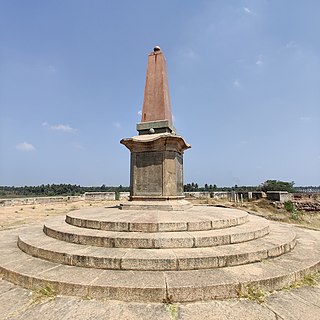
Obelisk Monument, also known as the Siege Monument, is a commemorative edifice built in Srirangapatna in the Indian state of Karnataka. It marks the memory of the British officers and native soldiers who lost their lives during the siege of Srirangapatna on 4 May 1799 during the last Fourth Anglo-Mysore war fought during 1798-99 between the British army and the forces of the Mysore Kingdom led by Tipu Sultan. The British army was led by the British General Harris. The memorial was built during the reign of Krishna Raja Wadiyar IV in 1907 as a mark of gratitude by the Wadiyars for getting back their throne from the Sultans.

Wellesley Bridge, Srirangapatna is an ancient stone bridge built in 1804 on the Highway road leading to Bangalore from Mysore in the state of Karnataka. This stone bridge is built across the north bank of the Cauvery River. When built it was the main first artery approach to the island town of Srirangapatna which was initially the capital city of the Wodeyar Dynasty of Mysore Kingdom after the death of Tipu Sultan in 1799. The bridge was dedicated to Marquis Wellesley who was the Governor-General of British India when it was completed, and it was inaugurated in October 1804. It was built under the overall supervision of Dewan, Purnaiah of the Kingdom of Mysore, as directed by the King Mummadi Krishnaraja Wodeyar.



